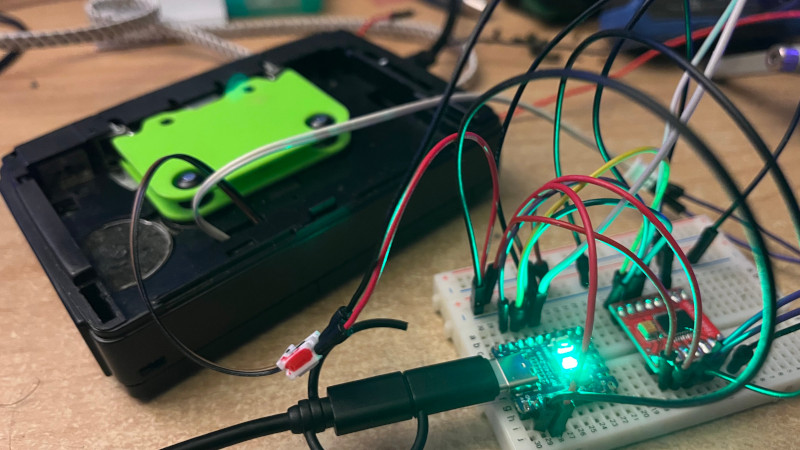Afficionados of vintage electric organs will know about the Melotron, an instrument from the 1960s that had pre-recorded sounds on a bank of tape loops. A real Melotron in working order will set you back a bit, but it’s possible to play with the idea using much more attainable hardware. [Decurus] has made a simple tape based synth using a cassette deck.
It uses a loop of cassette tape, and varies the pitch by changing the speed of the cassette motor. There’s an RP2040 and a motor controller, which can take a MIDI signal and use it to drive the motor. We’re sorry to see that there’s no recording of the result, but it’s described as a drone.
Part of this project is a 3D printed tape loop holder to fit a cassette mechanism. We won’t go as far as to call it a cassette in itself, instead it’s a sort of tape loop frame. We can see that it might be an interesting component for other tape loop experimenters, now that cassettes themselves are no longer ubiquitous. This certainly isn’t the first tape pitch synth we’ve seen.
















Story is incomplete without noting that this organ was a cheap/bad knockoff of a Hammond.
Hammond organs were much neater.
They had hard drive style platters (stacked high) rotating at variable speed with different effects at different radii.
You physically moved the read head(s) with a slide on the organ.
That was an epic hack.
Also: Remember analog delay effects?
Same thing, loop of tape.
They are completely different.
They all use looped magnetic media.
This was an obvious attempt at end running Hammond’s patients.
Classic hammond tonewheels aren’t really “magnetic media” in the same way that tapes are. They’re more like electric guitar strings – the tone wheel alters the electromagnetic field between a magnet and a pickup, but it’s not magnetized itself.
The physical shape of the tonewheel is what creates the sound, which is why they look so interesting! But it’s not capable of storing a recorded sound like the tape devices.
No, they don’t. No, it wasn’t.
The Hammond Organ does not use a loop of magnetic media. Neither does the Mellotron.
For those curious about the Melotron, here’s a video describing the Melotron 400:
https://youtu.be/ByD8gH7kYxs?feature=shared
Spring loaded tape segments are a fascinating solution. 1 read head per note seems a tad excessive but hey…
I always thought it was “Mellotron”. Because it is.
Wow, you win the internet for the day.
Please proceed to the nearest exit to receive your reward.
Mellotron (double l) – Both Jenny and you made that typo :)
It’s not a typo if I copied it from the article.
It doesn’t make it correct, but it doesn’t make it a typo either.
But hey, feel free to criticize on a platform that doesn’t allow editing or corrections, you look like a real winner. Keep winning.
I’m so sorry the idea of going “Oop, you’re right, I copied it from the article, and the article got it wrong. Hopefully they fix the article!” causes you such physical agony that you need to snidely lash out instead.
You must be REAL fun at parties, assuming you get invited to any after someone tried to gently correct something that you said, and in about five nanoseconds you were throwing your beer across the room, tearing off your shirt, and screaming for people to come at you. I pity your spouse if god forbid you have one.
Ok let’s all just take a deep breath!
😤…😮💨…😌
Ok much better. Now, WTF…I would say “gently” isn’t the best descriptor of the correction. It was a little bit condescending, but that could have been aimed at the author just as much as Mark. And yes Mark I understand your frustration and I see that your heart, coming into the conversation, was in the right place (sharing a link to melLotron 😉 info). But I think Andrew has the right to be frustrated as well after being challenged, after he was just trying to provide a correction. But we all just have to stop being anal about a typos and being judgmental about the little things that don’t matter, when I think we can all agree that HaHa (a.k.a Mr. Every single sound EVER is a magnetic tape loop!) rudely insisting that Laurence Hammond patented magnetic media storage and that Hammond organs had hard drive platters and read heads…in the 1930s? No! And Hammond organ motors don’t have variable speed either! I think this must be a case of HaHa being some gen Z kid that thinks tape is so old and outdated as a technology…that it must be in the same category as every other instrument you plugged in before digital synthesizers came out…
Hey HaHa…electromagnetic pick ups are not hard drive read heads…and the mellotron was nothing like a Hammond organ…besides the fact that they were both played with a piano style keys. And even that statement is misleading bc organs were around far longer than pianos…so in reality, organ manuals…they are both played with organ manuals. And don’t knock the mellotron so much…it was a bit cumbersome, and had to have its quirks and kinks ironed out on a daily basis…but there were a lot of moving parts and before synths were really attainable (or playable) the mellotron served a purpose quite well.
Just remember…there was a world before the Xbox One was invented…and not everything was a tape loop. But this cool little electronics project is…what about that? I thought this was gonna be 11, well I guess now 12) on a tiny tape synth…
So…any thoughts on that guys?